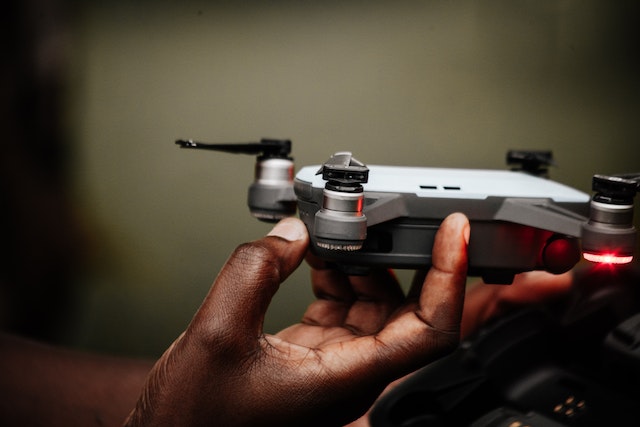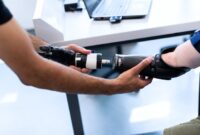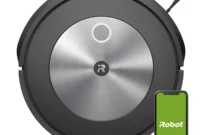Drones have revolutionized various industries, and their potential is rapidly expanding. In recent years, the utilization of professional drones has soared, enabling businesses to enhance efficiency, reduce costs, and improve safety in a wide range of applications. Whether it’s capturing breathtaking aerial photography, conducting aerial surveys, or inspecting infrastructure, professional drones are transforming the way we work. In this article, we will explore the power of professional drones, their applications across different industries, the advantages they offer, factors to consider when choosing one, best practices for flying, and the future trends shaping the industry.

1. Introduction
Professional drones, also known as unmanned aerial vehicles (UAVs), are advanced aerial devices equipped with high-quality cameras and sensors. They are designed to perform specific tasks with precision and accuracy. By combining autonomous flight capabilities with cutting-edge technology, professional drones have become indispensable tools for businesses seeking innovative solutions.
2. Understanding Professional Drones
2.1 What are professional drones?
Professional drones are sophisticated aerial devices that are used for commercial purposes. They are equipped with advanced features such as GPS navigation, obstacle avoidance systems, and high-resolution cameras. These drones are designed to carry out a wide range of tasks, including aerial photography, surveying, inspections, and delivery.
2.2 Applications of professional drones
The applications of professional drones are diverse and rapidly expanding. They are widely used in industries such as construction, agriculture, filmmaking, surveying, and more. Professional drones have proven to be valuable tools for:
- Capturing stunning aerial photographs and videos for advertising, cinematography, and real estate.
- Conducting inspections of infrastructure, such as buildings, bridges, and power lines, for maintenance and safety purposes.
- Assisting in search and rescue operations by providing real-time aerial footage and mapping inaccessible areas.
- Monitoring and managing crops in agriculture, allowing farmers to optimize irrigation, fertilization, and pest control.
- Creating accurate 3D maps and models of landscapes, construction sites, and archaeological sites.
- Supporting environmental conservation efforts by tracking wildlife, monitoring habitats, and identifying ecosystem changes.
3. The Advantages of Using Professional Drones
3.1 Efficiency and Time-Saving
One of the significant advantages of using professional drones is the efficiency they bring to various tasks. Drones can quickly cover large areas and capture high-resolution images or videos in a fraction of the time it would take with traditional methods. This time-saving aspect allows businesses to streamline operations, increase productivity, and allocate resources more effectively.
3.2 Cost-Effectiveness
In addition to saving time, professional drones offer cost-effective solutions. Traditional methods for tasks like aerial inspections, mapping, or surveying often require expensive equipment, manpower, and specialized vehicles. Drones eliminate or significantly reduce these costs, making these services more accessible to businesses of all sizes. Moreover, drones can collect data with precision, reducing the chances of errors and the need for rework.
3.3 Safety Improvements
Professional drones enhance safety by minimizing the need for humans to perform risky tasks. For example, inspecting tall structures or accessing hazardous areas can be dangerous for personnel. By deploying drones for such tasks, businesses can protect their employees while still obtaining accurate and comprehensive data. Drones can also access hard-to-reach locations, reducing the risks associated with human-operated equipment.
4. Industries Benefiting from Professional Drones
Professional drones have found applications in various industries, revolutionizing traditional workflows and unlocking new possibilities. Let’s explore some of the sectors benefiting from the power of professional drones.
4.1 Construction and Infrastructure
In the construction industry, professional drones are used for site surveys, project monitoring, and inspecting structures. Drones equipped with high-resolution cameras and thermal imaging sensors can capture detailed data, helping architects, engineers, and construction teams make informed decisions. Drones can also create accurate 3D models of construction sites, facilitating better project planning and reducing errors.
4.2 Agriculture and Farming
The agricultural sector has embraced professional drones for crop monitoring, precision agriculture, and livestock management. Drones equipped with multispectral cameras can capture data about crop health, nutrient levels, and water distribution. This data enables farmers to optimize irrigation, identify diseased plants, and apply targeted treatments, resulting in improved yields and reduced resource waste. Drones can also be used for livestock surveillance, helping farmers monitor the health and behavior of their animals.
4.3 Filmmaking and Photography
Professional drones have transformed the field of filmmaking and photography by providing unique perspectives and stunning aerial shots. With their ability to capture cinematic footage and high-resolution images, drones have become an integral part of the entertainment industry. They allow filmmakers, photographers, and content creators to unleash their creativity, producing captivating visuals that were once only possible with expensive equipment or helicopters.
4.4 Surveying and Mapping
In the field of surveying and mapping, professional drones have revolutionized data collection and analysis. Drones equipped with high-accuracy GPS receivers and LiDAR sensors can quickly and accurately map large areas, generating detailed topographic maps and elevation models. This data is invaluable for urban planning, land development, environmental assessments, and disaster management.
5. Factors to Consider When Choosing a Professional Drone
When selecting a professional drone, several factors need to be taken into consideration to ensure it meets the specific requirements of the intended applications. Here are some key factors to consider:
5.1 Payload Capacity
Different tasks may require specific payloads, such as high-resolution cameras, LiDAR sensors, or thermal imaging equipment. It’s essential to choose a drone that can carry the necessary payload weight comfortably.
5.2 Flight Time and Battery Life
The flight time and battery life of a drone determine its operational duration. Longer flight times allow for extended missions without frequent battery changes or recharging. Consider the required flight duration for your intended applications.
5.3 Control Range and Connectivity
The control range and connectivity of a professional drone are crucial, especially for tasks that require long-range operations or real-time data transmission. Ensure that the drone’s range and connectivity capabilities align with your specific needs.
5.4 Camera Quality and Stabilization
For tasks involving aerial photography or videography, the camera quality and stabilization features of a drone are vital. Look for drones with high-resolution cameras, adjustable settings, and built-in stabilization technologies to capture professional-grade visuals.
6. Best Practices for Flying Professional Drones
Flying a professional drone requires adherence to safety guidelines and best practices to ensure successful and incident-free operations. Here are some essential practices to follow:
6.1 Registering and Understanding Regulations
Before flying a professional drone, it is crucial to register it with the appropriate aviation authorities and comply with local regulations. Familiarize yourself with the airspace restrictions, flight altitude limits, and any additional requirements specific to your location.
6.2 Conducting Pre-flight Checks
Performing pre-flight checks is essential to ensure the drone’s airworthiness and identify any potential issues. Inspect the drone, batteries, and propellers for damage or wear. Verify that the firmware and flight control systems are up to date.
6.3 Planning and Executing Flights
Before each flight, plan the mission, considering factors such as weather conditions, airspace restrictions, and flight objectives. Create a flight path, set waypoints, and ensure that the drone’s flight parameters are properly configured. Monitor the drone during the flight and be prepared to adjust the plan if necessary.
6.4 Data Management and Analysis
Once the flight is complete, it’s essential to manage and analyze the collected data effectively. Develop a data management strategy that includes organizing and storing the data securely. Use appropriate software tools to process and analyze the data, extracting valuable insights for decision-making.
7. Future Trends in Professional Drones
The field of professional drones is continuously evolving, driven by technological advancements and innovative applications. Here are some future trends shaping the industry:
7.1 Artificial Intelligence and Automation
The integration of artificial intelligence (AI) and automation is set to revolutionize professional drone operations. AI-powered drones can perform complex tasks autonomously, such as object detection, tracking, and data analysis. This automation will further enhance efficiency, accuracy, and safety.
7.2 Enhanced Sensors and Imaging Technology
Advancements in sensor technology will lead to improved data collection capabilities. Drones will incorporate more advanced sensors, such as hyperspectral cameras, LiDAR systems, and multispectral sensors, enabling more precise measurements, analysis, and monitoring.
7.3 Delivery and Logistics Solutions
The use of drones for delivery and logistics is an emerging trend with vast potential. Companies are exploring drone-based delivery systems to transport goods, medical supplies, and even food in remote or congested areas. Drone delivery offers fast and cost-effective solutions, particularly for urgent or time-sensitive deliveries.
8. Conclusion
Professional drones have unleashed a new era of possibilities across industries, offering enhanced efficiency, cost-effectiveness, and safety. Their applications range from aerial photography to infrastructure inspections, revolutionizing traditional workflows and driving innovation. By considering factors like payload capacity, flight time, and camera quality, businesses can choose the right drone for their specific needs. Adhering to best practices and staying informed about regulations ensures safe and successful drone operations. As the industry evolves, advancements in AI, sensor technology, and delivery solutions will shape the future of professional drones, opening up even more opportunities for businesses to leverage their power.
9. FAQs
9.1 How much do professional drones cost?
The cost of professional drones varies depending on their features, capabilities, and payload options. Entry-level drones can range from a few hundred dollars, while high-end professional drones can cost several thousand dollars.
9.2 Are professional drones difficult to operate?
Operating professional drones requires some level of training and practice. However, with advancements in technology and user-friendly interfaces, many drones are designed to be user-friendly, making them accessible to beginners as well.
9.3 Can professional drones fly in all weather conditions?
Professional drones have specific limitations when it comes to adverse weather conditions such as heavy rain, strong winds, or extreme temperatures. It’s essential to follow manufacturer guidelines and avoid flying in conditions that may compromise the drone’s performance or safety.
9.4 What certifications or licenses are required to fly professional drones?
The requirements for certifications and licenses to fly professional drones may vary depending on the country or region. It is crucial to research and comply with the specific regulations and obtain the necessary certifications or licenses if required.
9.5 How can professional drones benefit the environment?
Professional drones can benefit the environment in several ways. By providing valuable data for precision agriculture, they help optimize resource usage, reduce chemical inputs, and minimize environmental impact. Drones can also assist in monitoring and conserving natural habitats, supporting wildlife management efforts, and contributing to environmental research and conservation initiatives.


